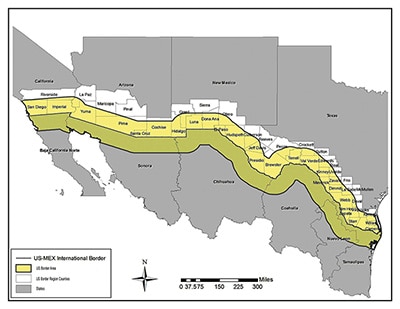
The U.S.-Mexico Border Health Commission (Commission) is proud to host the Border Health Observatory (Observatory)/Observatorio de Salud Fronteriza (Observatorio). This centralized data portal characterizes the U.S.-Mexico border region as a geographic unit comprised of the 44 U.S. counties in California, Arizona, New Mexico and Texas (as seen in Figure 1).
As defined in the La Paz Agreement of 1983 and Public Law 103-400 of 1994, the “United States-Mexico Border Area” means the area of land located within 100 kilometers (62.5 miles) north and south of the international boundary. It stretches approximately 2000 miles from the southern tip of Texas to California. The La Paz designated area includes 44 counties in 4 U.S. states and 80 municipios in 6 Mexican states.
The Centers for Disease Control and Prevention’s National Center for Health Statistics (NCHS) and Division of Global Migration and Quarantine/US-Mexico Unit (DGMQ/USMU) contributed to the design, adaptation and development of the data tools in the Observatory to help identify and address health disparities, emerging issues and priority health concerns at the U.S.-Mexico border region.
The Observatory contains weblinks to U.S. federal agencies public use interactive data analysis and visualization tools, tailored to examine select health indicators for the U.S. side of the U.S.-Mexico border. These datasets will inform public health research, priority setting, program evaluation and resource allocation for the U.S.-Mexico border region.
The objective of the Observatory is to make data access, analysis and visualization easy and available to local communities, scholars, policy researchers, states and federal agencies, health care provider organizations and other stakeholders.
Observatory Data Tools
The Observatory website links offer access to three data tools that include ad-hoc queries, summary statistics, maps and charts. Each tool is focused on a specific health issue or topic. In addition, the available data can be organized into a variety of categories including comparisons of specific geographic regions and population demographics to express common measures in multiple ways (frequency counts, percentages, rates).
- CDC Wonder US-Mexico Border Area Mortality
- HCUPnet from the Healthcare Cost and Utilization Project (HCUP)
- U.S.-Mexico Border Atlas of Infectious Diseases
- HRSA Data Map Tool
The weblinks for each data source are available in several file formats, including webpages (HTML), chart and maps images (jpeg), and spreadsheet files (simple text, [ASCII] with tab-separated values, and can be easily shared with social media venues like Facebook, Instagram, etc.). The data tools provide the ability to download the data in several formats for further analysis and display. Along with this capability, the public-use data at the Observatory will be updated on an annual basis by the independent agency. Below is a brief description of each data tool weblink along with the point of contact.
Coming Soon!
- Border Socio-Demographic Information via Census Business Builder*
- Portal to Other Border Data Resources* (reports, links to websites, mapping tools and key resources)
- Infectious Disease Dashboard* (interactive web-based morbidity tool to visualize and analyze infectious diseases for the border region)
- Healthy Border 2020 Mid-term and Closeout Report (Available July 2020)
- Healthy Border 2020 Report Card (live data web links to sort by border health indicator)
- Webinars (a series of “how to steps” for utilizing the Observatory)
- Observatory Glossary (list of definitions, usage of terms and meanings)
